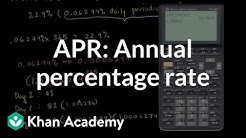Contents
annual percentage rate (APR) The cost to borrow money expressed as a yearly percentage. For mortgage loans, excluding home equity lines of credit, it includes the interest rate plus other charges or fees. For home equity lines, the APR is just the interest rate.
A number of factors-such as term, type of interest rate (see below), etc.-can affect the cost of credit and make it hard to compare multiple loans. The APR.
APR (or annual percentage rate) is the higher of the two rates and reflects your total cost of financing your vehicle per year including fees and interest accrued to the day of your first payment (APRs are useful for comparing loan offers from different lenders because they reflect the total cost of financing)
Interest rate vs APR-Knowing the answer is essential to understanding the true cost of borrowing. Can you tell one from the other?
Us Mortgage Rate History HSH’s Fixed-Rate mortgage indicator (frmi) averages 30-year mortgages of all sizes, including conforming, expanded conforming, and jumbo. The FRMI has been published as a continuous series since the early 1980s.
The APR, however, is the more effective rate to consider when comparing loans. The APR includes not only the interest expense on the loan but also all fees and other costs involved in procuring.
According to Experian, the average personal loan balance is $15,143, the average monthly payment is $353, and the average annual percentage rate (APR) is 9.37%. APR is a broader measure of loan costs.
New Home Construction Loan Interest Rates The higher mortgage rates that have made it tougher for buyers to afford new homes could bring remodelers more business. housing analysts predict many homeowners will be reluctant to trade current.
A lot of terms get thrown around when you get financing for your business. Two common ones are interest rates and APR, what's the.
 If you're applying for any type of loan, the first thing you'll probably look at is the interest rate. Further down the application, you'll also see a.
If you're applying for any type of loan, the first thing you'll probably look at is the interest rate. Further down the application, you'll also see a.
Interest rate vs APR-Knowing the answer is essential to understanding the true cost of borrowing. Can you tell one from the other?
Whether you’re a first-time landlord or an experienced one, there are frequent regulatory changes in the buy-to-let sector.
For example, short-term high interest rate loans will often have a 30% interest rate for a two week term, or $30 owed for every $100 borrowed-which translates into a 782.14% APR. APR vs. Interest Rate. The difference between an APR and an interest rate is that the APR equals the interest rate plus other loan costs.